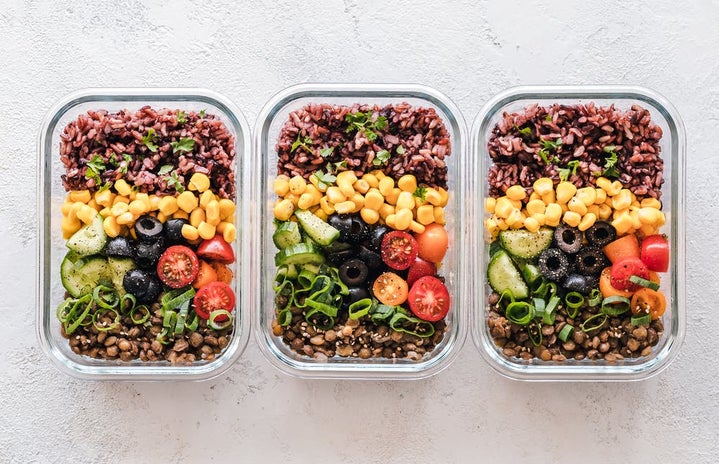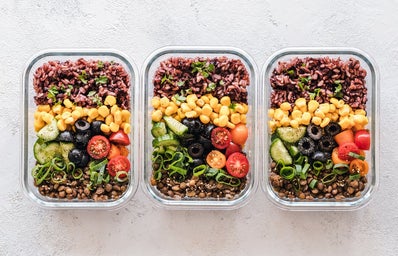Picture this: It’s finals week, and you’re drowning in assignments, exams, and the pressure to maintain a social life. In the midst of this chaos, a nutritious meal seems like a distant dream. But what if I told you that meal prep can be your lifesaver in college?
Meal prepping is a proactive approach to food preparation where individuals plan, cook, and assemble meals in advance, typically for the upcoming week. This involves cooking multiple servings of different dishes and portioning them into individual containers, making it easier to manage and streamline one’s daily eating routine. The purpose of meal prepping is to save time, maintain a balanced and nutritious diet, and often to adhere to specific health or fitness goals. By having pre-prepared meals readily available, individuals can avoid the stress and time constraints of daily cooking while ensuring they have convenient, healthy options at hand. As a college student, I understand the struggle of balancing academics, social activities, and a tight budget, all while trying to eat well.
Meal prepping is a valuable skill to learn during your college years. By investing a little time and effort upfront, you can enjoy the benefits of delicious, healthy, and affordable meals of your liking throughout the week. Get started with my tips and recipes, and discover how meal prepping can revolutionize your college dining experience.
Tips for successful meal prepping
- Plan your meals
-
Take some time to create a meal plan for the week. Consider your schedule, dietary needs, and budget to come up with a variety of balanced and flavorful meals. Usually I would get a half size pack of rice and one pack of chicken breast, which is about $15 to $20.
- Invest in quality containers
-
Choose airtight and stackable containers that can withstand microwave and freezer use. This will help you keep your meals fresh and organized. You can find containers at a local Family Dollar store, Walmart, or Amazon. Some brands I recommend are S Salient, Tupperware, and Rubbermaid.
- Batch cook and freeze
-
Spend a day each week cooking and portioning out your meals. Freeze them in individual servings so you can grab and go when you need them.
- Multitask in the kitchen
-
Utilize your time efficiently by multitasking. For example, while your chicken is baking or frying, chop vegetables or cook rice simultaneously.
- use pre-cut and frozen ingredients
-
Simplify your meal prep process by utilizing pre-cut vegetables and frozen or fresh fruits. They are convenient, time-saving, and still packed with nutrition. Personally, I like to get fresh broccoli and fruits instead of a frozen pack of vegetables and fruit.
- Cook in large batches
-
Prepare large portions of staple foods such as quinoa, roasted vegetables, or grilled chicken, that can be used in multiple meal combinations throughout the week.
I have also compiled a few recipe ideas for meal prepping.
Budget-friendly meal prep ideas
- Overnight oats
-
Make a week’s worth of delicious and nutritious overnight oats by combining rolled oats, yogurts, milk, and your favorite toppings like fresh fruits and nuts.
- Rice and bean bowls
-
Cook a large pot of rice and beans, and portion it into containers with steamed veggies and a drizzle of sauce for a budget-friendly and protein-packed meal.
- Veggie stir-fry
-
Saute a mix of colorful bell peppers, broccoli, and tofu, then divide it into individual servings. Serve it over white or brown rice or quinoa for a quick and nutritious meal.
- Quinoa salad with veggies
-
Enjoy a refreshing and nutritious salad with cooked quinoa, mixed greens, and a tangy vinaigrette. It’s a satisfying meal you can easily pack for lunch or enjoy as a light dinner.
- Grilled chicken with roasted vegetables
-
Marinate chicken the night before in your favorite herbs and spices, then grill them to perfection. Serve with a side of roasted vegetables for a balanced and flavorful meal.
- Turkey wrap with hummus
-
Fill a whole wheat wrap with lean turkey, fresh veggies, and a generous spread of hummus. Wrap it tightly and refrigerate for a quick and nourishing grab-and-go option.
Harvard University emphasizes the importance of a balanced and nutritious diet for students. It recommends incorporating a variety of fruits, vegetables, whole grains, and lean proteins. Harvard also encourages mindful eating, staying hydrated, and being aware of portion sizes. Additionally, students can make use of campus resources, like nutrition services, to get personalized guidance.



